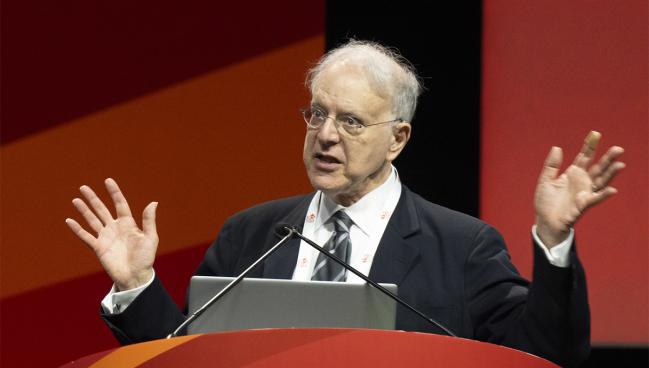SUMMIT: Tirzepatide a ‘Huge Win’ for HFpEF Patients With Obesity
HF specialists agree these drugs will be key tools in fighting the obesity-related HFpEF epidemic. Hurdles and questions remain.

Photo Credit: American Heart Association
CHICAGO, IL—Tirzepatide (Eli Lilly) significantly cut the risk of cardiovascular mortality and worsening heart failure events by nearly 40% over a median follow-up of roughly 2 years in patients with obesity and heart failure with preserved ejection (HFpEF), results of the SUMMIT trial show.
The treatment benefit was driven by a significant reduction in the risk of worsening HF events requiring hospitalization or urgent need for intravenous medication, a benefit that emerged after 3 to 4 months.
“Heart failure with a preserved ejection fraction is now the most common phenotype of heart failure. and the driver of this phenotype is obesity,” lead investigator Milton Packer, MD (Baylor University Medical Center, Dallas, TX), told the media. “We’re talking about an epidemic of obesity in the United States and worldwide, and the most serious and most common cardiovascular complication in obesity is heart failure with a preserved ejection fraction.”
Presenting the full SUMMIT results today during the late-breaking clinical trials session at the American Heart Association (AHA) 2024 Scientific Sessions—topline results were announced in August—Packer reported that in addition to the reduction in worsening HF events, tirzepatide significantly improved health status and exercise tolerance, as well as decreased body weight and systemic inflammation.
Robert Mentz, MD (Duke University School of Medicine, Durham, NC), said SUMMIT, along with other data supporting the use of semaglutide (Wegovy/Ozempic; Novo Nordisk), is a win for this growing patient population.
“Many patients are coming into clinic asking about these medications, really seeking an effective way for weight loss,” Mentz told TCTMD. “Now, these data, in combination with the STEP-HFpEF program, are really building this case that there's not just improvements in ‘function and feel’ endpoints, but really there’s this clinical outcome benefit as well.”
These data . . . are really building this case that there's not just improvements in ‘function and feel’ endpoints, but really there’s this clinical outcome benefit as well. Robert Mentz
In 2023, the STEP-HFpEF study and STEP-HF DM showed that treatment with the glucagon-like peptide-1 (GLP-1) receptor agonist semaglutide was effective for improving symptoms and physical limitations in patients with obesity and HFpEF. A pooled analysis of several trials with semaglutide in HFpEF also showed that treatment reduced the risk of cardiovascular or worsening HF events, and like in SUMMIT, the benefit was driven by a reduction in worsening HF events.
Sanjiv Shah, MD (Northwestern Feinberg School of Medicine, Chicago, IL), another HF specialist, said this latest study proves that the large benefits observed with semaglutide in the two STEP-HFpEF trials wasn’t due to chance.
“With SUMMIT, I think we really feel comfortable saying that these drugs are here to stay for HFpEF,” he said. “They're making a huge difference in the lives of our patients already and I think we finally have the proof to show the world that obesity is really a major driver of the HFpEF syndrome. By really attacking the main cause of HFpEF, we’re seeing a really big benefit.”
Obesity Driving HFpEF Pathophysiology
Tirzepatide, a dual glucose-dependent insulinotropic polypeptide (GIP) and GLP-1 agonist, is approved by the US Food and Drug Administration under the trade name Zepbound for chronic weight management in adults with obesity or overweight with at least one weight-related condition. It was first approved in 2022, under the trade name Mounjaro, for the treatment of type 2 diabetes. Tirzepatide is also approved in Europe for obesity management and type 2 diabetes.
Speaking with the media, Packer explained that visceral adiposity drives the pathophysiology in HFpEF. The expansion and biological transformation of visceral fat—a change into what he called “angry adipocytes”—leads to sodium retention and plasma volume expansion, as well as myocardial injury and fibrosis. In turn, this results in increased LV filling coupled with a decreased ability of the LV to tolerate that filling.
SUMMIT included 731 patients (mean age 65.2 years; 53.8% female) randomized to placebo or tirzepatide and treated for up to 3 years. The mean BMI at baseline was 38 kg/m2 and 47% of patients had HF decompensation within the previous 12 months. High-sensitivity C-reactive protein (hs-CRP) levels were also significantly elevated (5.8 mg/dL).
“These patients were really impaired,” said Packer. “They had very low KCCQ scores, very poor kidney function, very limited exercise tolerance, half had a recent heart failure decompensation, and levels of CRP, a marker of systemic inflammation, were markedly elevated.”
With SUMMIT, I think we really feel comfortable saying that these drugs are here to stay for HFpEF. Sanjiv Shah
At baseline, nearly three-quarters were taking a diuretic, more than 80% were taking a renin-angiotensin system/neprilysin inhibitor, and roughly 70% were taking a beta blocker. Mineralocorticoid-receptor antagonists were used in a little more than a third of all patients while SGLT2 inhibitors were used in 19% of tirzepatide-treated patients (and 15.5% of placebo-treated patients).
Patients in the active treatment arm were started on tirzepatide 2.5 mg/week and uptitrated, as tolerated, to a maximum of 15 mg/week.
The primary endpoint of deaths from cardiovascular causes or a worsening HF event occurred in 9.9% of patients in the tirzepatide group and in 15.3% in the placebo arm (HR 0.62; 95% CI 0.41-0.95). The benefit was driven by a reduction in the risk of worsening HF events resulting in hospitalization, intravenous drug therapy in an urgent care setting, or intensification of oral diuretic therapy: 8.0% in the tirzepatide arm versus 14;2% in the placebo group (HR 0.54; 95% CI 0.34-0.85). With respect to hospitalizations for HF alone, the event rate was 3.3% with tirzepatide versus 7.1% with placebo (HR 0.44; 95% CI 0.22-0.87).
Adjudicated deaths from cardiovascular causes occurred in 2.2% of the tirzepatide-treated patients and 1.4% of those in the placebo arm, a nonsignificant difference. Pressed on the numerically higher rate in the tirzepatide arm, Packer stressed that numbers were small (eight vs five cardiovascular deaths) and that no signal of harm was observed in prior trials with tirzepatide.
“The play of chance [with] small numbers is known to be very, very mischievous,” said Packer.
Regarding health status, there was a significant improvement in the Kansas City Cardiomyopathy Questionnaire (KCCQ) clinical summary score, with the between-group difference of 6.9 points at 52 weeks favoring tirzepatide (P < 0.001).
In terms of other secondary endpoints, there was an 18-m placebo-corrected improvement in the 6-minute walk distance, while the percent change in body weight from baseline also favored the weight-loss medication (13.9% vs 2.2% reduction; P < 0.001). Additionally, there was a significant 38.8% reduction in hs-CRP levels with tirzepatide compared with a 5.9% reduction in the placebo group (P < 0.001).
The rate of discontinuation due to gastrointestinal symptoms was 4.1% with tirzepatide, a finding in line with prior studies.
Huge Win for Patients
Jennifer Ho, MD (Beth Israel Deaconess Medical Center, Boston, MA), an advanced HF physician who spoke with the media, called SUMMIT a “practice-changing trial,” adding that it cements incretin-based therapy as one of the cornerstones for obesity-related HFpEF.
“I struggle every day in clinic with how to make our patients with HFpEF feel better,” said Ho, noting that by some estimates 80% of patients with HFpEF have obesity or are overweight. “This is an enormous problem. This is a study that isn't just targeted at a small subgroup of patients with HFpEF. This is going to affect how we think about the majority of patients with HFpEF.”
Shah noted that patients with HFpEF are frequently older with significant comorbidities. While there was no difference in cardiovascular mortality with treatment, that’s not necessarily the goal.
“Everyone, I think, would want to live longer, but they’re suffering so much that I think living better and staying out of the hospital are important goals,” he said. “So, for our patients, this is a huge win.”
Shah added there’s more work to do, noting that there is still a degree of residual risk and patients still have symptoms despite treatment. There is also variability in how they respond to treatment.
“This really opens the door to alternative ways of combating the obesity epidemic and its relationship with HFpEF,” he said. “Not every patient responds similarly to this, and at the same time, this is only one mechanism by which we can improve and reduce obesity and all its consequences. I think that we’ll see multiple studies from STEP-HFpEF, and we’ll probably see it from SUMMIT as well, that weight loss is a major mechanism of benefit, but there probably is something else going on.”
This is going to affect how we think about the majority of patients with HFpEF. Jennifer Ho
To TCTMD, Mentz noted that while there was a lack of treatment available for HFpEF patients in the past, the field has seen a number of breakthrough therapies. These include SGLT2 inhibitors following positive results from EMPEROR-Preserved and DELIVER, as well as with the nonsteroidal mineralocorticoid receptor antagonist finerenone (Kerendia; Bayer) in FINEARTS-HF.
He said that when thinking of a clinical outcomes study, cardiologists are accustomed to tens of thousands of patients with hundreds of clinical events, but the numbers here are much more limited.
“This was 731 patients and while it was a well-executed trial, it really was still a fairly modest number of events—the primary endpoint in total only had 92 events,” he said. “A large relative risk reduction, but I think the results need to be kept in context.”
Despite that, Mentz said SUMMIT provides data showing a benefit in terms of HF hospitalizations beyond the improvement in symptoms and function seen in STEP-HFpEF.
Getting on, and Staying on, Medication
To the media, Ho said that with some of the latest successes, implementation of proven medical therapy will be the next challenge in HFpEF.
“This is probably where a lot of future work needs to be done,” she said. “There are many, many barriers that our patients and our providers face, including access, including costs, and including health inequities. I would say GLP-1 [receptor agonist] discontinuation is an enormous problem. Something like 10% of individuals who initiate on GLP-1s stop medications by 6 weeks. If you look at 1 year in patients with an obesity indication, 50% of patients are off their medication.”
Packer said that when patients stop the medications, they regain the weight.
“And it’s my expectation that their heart failure symptoms [would return] and event rates will go back to where it was before treatment,” he told TCTMD. “I think they need to take the drug to able to mute the inflammation.”
Shah said that it’s been challenging for patients to access the weight-loss medications, particularly if they don’t have diabetes. Even those denied coverage, however, are desperate enough for treatment that they’re finding alternative means to access the medications, including by paying out of pocket.
“It's really important that we as the healthcare community advocate for these patients, to really try to do whatever we can to get the prices down and get the drugs covered for our patients,” he said.
Michael O’Riordan is the Managing Editor for TCTMD. He completed his undergraduate degrees at Queen’s University in Kingston, ON, and…
Read Full BioSources
Packer M, Zile MR, Kramer CM, et al. Tirzepatide for heart failure with preserved ejection and obesity. N Engl J Med. 2024;Epub ahead of print.
Disclosures
- Packer reports consulting for 89Bio, AbbVie, Altimmune, Amarin Pharma, Amgen, Ardelyx, ARMGO, AstraZeneca, Attralus, Biopeutics, Boehringer Ingelheim, Caladrius, Casana, CSL Behring, Cytokinetics, Imara, Moderna, Novartis, Novo Nordisk, Reata, Regeneron, Relypsa, and Salamandra.






Comments